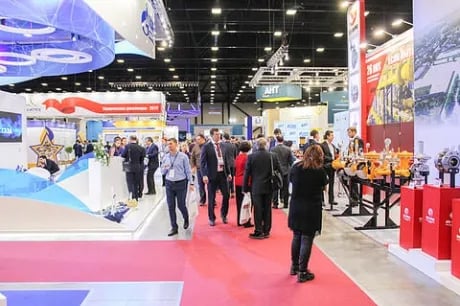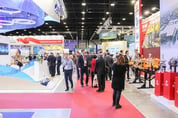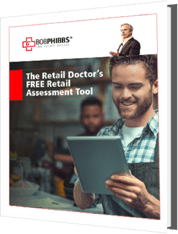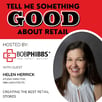Podcast Episode 201: NRF 2019 | 3 Takeaways from Retail's Big Show

Season 2 kicks off from the National Retail Federation's Big Show in New York as Bob Phibbs speaks with Mark Bunny from Ingenico about how to deal with a diner's pet peeve about waiting for a check, Joel Reed CEO, IAM Robots and why there is such a need for robots and Bob talks data with My Store-E Co-Founder Idan Sergi about his new app that combines online and offline data for more effective merchandising and selling .

Tell me something good about retail
NRF 2019: 3 Takeaways from Retail's Big Show
Bob: Hey, it's Bob Phibbs here at the NRF for 2019. I am thrilled to be talking today with Mark Bunny with Ingenico. So, they are a payment solutions company. And you might have heard of them because they have been around for like 40 years. What you might not know is they are like the engine that drives an awful lot of brick-and-mortar retailers, right? So, I mean, I know Apple or BestBuy or some of those guys but they are using their product for payments.
So, we're having this conversation about hospitality and retail and they are in the restaurant business, right? So, here is my pet peeve. We're here, we're having dinner, we've dropped 200 bucks, maybe 300 bucks with drinks, I don't know, and dessert. And so, we are ready for dessert. I mean, should be. We're ready. Table has full of stuff. We're ready. We're like ready. What are we doing?
Mark: We're waiting for the check.
Bob: Because we didn't put enough staff on or maybe it doesn't really like waiting on two guys. They're business guys, they won't tip. Or fill in the blank. But meanwhile, our temperature is going up. So, what's happening is our likely hood to tip the server are going really far down. At least for me, I don't know about you. Because meanwhile, we are also taking up a whole table, right?
That you could have turned pretty quickly as well as now you don't know really how to schedule. Did we...was, you know, are people taking longer at tables? You are just assuming people are enjoying their dinner more at restaurants but what the hidden part is no, that's not really it. But they are not coming back to you. So, tell me. So, Mark was telling me, so how do you sell that? You guys have a new solution.
Mark: Yes, we have a new Pay-at-the-Table solution that we have been using around the world that we're actually implementing in the U.S. And, in fact, one of our customers implemented this and they were actually able to turn table, turning the tables and save nine minutes.
Bob: I know most of you in retail follow me you're like, "Well, big deal? Nine minutes in my store. What's the big deal?" Is that a big deal?
Mark: Well, actually, it actually increases the revenue 15% per location.
Bob: A 15% increase per location? That's huge. I mean retail last year was growing with a 5% increase but you're getting...
Mark: 15%.
Bob: Did the check go up or the tips go up?
Mark: The check didn't go up necessarily. But actually, the tips actually improves because it made it easier for a consumer to actually enter 20, 15, 18%, done. And the best part of it is your experience last night, you no longer had to wait. They could get it, pay, and then actually get out the restaurant. So their experience is actually improved.
Bob: Rhe pain point for me that is huge is people with money who are going out to eat are the lifeblood of most cities. And most retailers, you know, malls today are looking at how do we get more restaurants in because that's where the money is. People go out, they spend, and then their ancillary business around it. Why isn't every restaurant group talking to you? So, there you are with your wife and three kids. And now, you are waiting around at the table.
Mark: Yes, that doesn't create the best family experience by any means. Most especially when the kids are crying. Your wife is a little perturbed. And they just want to get out.
Bob: And so, whose fault are they looking at? It's Dad's fault. Where's the waiter? Why isn't the waiter back here? And then the waiter is so short-sifted or any number of things. Meanwhile, if you cut off nine minutes is a long time that those tables could turn; that's how you get your 15%.
More importantly, no one loses in this. The customer which is what you have all based on is customer-focused. They win, the user experience is great. It gets us back to that day of swiping a card and I'm out. We are all about convenience. The waiter is happy to get their checks. And they don't have people grumpy, right?
Mark: Hopefully, they'll come back to that waiter.
Bob: Hopefully, they'll come back because that person took the time. Because I get it. Let's say you come out with this app and half of your crew says, "We don't have to do that." But you get those smart ones who do, suddenly they're going to have a passionate following. In fact, small tip for restaurants...
One of my buddies was the number one guy; he got the highest sales at the restaurant over and over again. And other servers were asking, "How do you do it?" He said, "I have them order dessert before I ever show them the rest of the menu." I was like, "Dude, brilliant."
So, what happens is they order dessert, right? And then at the end of the meal, "We're too full for dessert." "Oh, that's okay. I can make it to go." "Great."
But it's about creating a better experience to the customer. Because ultimately, they want to treat themselves with dessert. And ultimately, the same thing with us. We go out to dinner, we want to have a great experience. Where does it fall short? It's waiting for the damn check. So, I don't know why every restaurant isn't beating a path to these guys, Ingenico. I'm sure Mark and his team would love to hear from you. How do they find out more about your product?
Mark: They can go to ingenico.us. And more than happy to talk with anyone and help you get to Pay-at-the-Table solution.
Bob: The one that no one is talking about here at NRF is the number one pain point for people who are successful and out shopping and dining, that's what I go back to. These are people who are voting with their feet and their wallets to go to a brick-and-mortar restaurant.
So many restaurants don't get it. Because now, they're like, "Oh, we havre GrubHub."
The problem is you have a beautiful restaurant, you just spent half a million, $1 million bucks on, and you're like, "Oh, well, everybody just wants to order online."
Why are they doing that? Because they don't want to have to wait and wait for a damn waiter. I just had to get that out.
So, if I didn't already say that, remember, also in training, that just because you came up with this app doesn't mean everyone's going to use it. So you have to explain it to your crew in a way that explains, "Hey, this is going to make you more money." That's all that matters. And the customers are going to like you better. And as you said, they are going to come back for you instead of just saying, "Well, I have already been there." Because they are going to love the idea I can get out when I'm ready to go.
Mark: That's right.
Bob: I am totally sold on this. So again, there's an awful lot of bells and whistles out there saying, "How do we get less involvement with customers?" I'm saying, "No. Just do a better job of creating an exceptional experience." And it all comes at that last moment, it's my last impression of you.
-
Bob: I was on a press tour yesterday. And I was so impressed with this guy, Joel, at IAM Robotics that I said, "Dude, you have to explain it to me again." So what are we looking at?
Joel: Thank you for the nice compliment. I appreciate it. I actually think the robot's more the attraction.
Bob: Is that what it is? So what are we looking at over here?
Joel: So you're looking at our Swift product, which is an autonomous robot that both transports and picks items in warehouses and retail environments.
Bob: So before we go too far, one of the things I appreciate about what you said yesterday, first off, this is for a warehouse. So we've got that. But you were going to be working on one that actually works on the sales floor, right?
Joel: Well, this is why we're at NRF this week, is just to start having conversations with the retail industry. We're listening more than we're talking this week. So we do have a robot that primarily is distributed into warehouses. But we're doing e-commerce fulfillment.
Bob: And so here's the thing that I was so impressed with what you said, about the need for one of these in the store. You know what it was?
Joel: Because you physically can't pick enough orders for online based on demand. The the trend is that Americans in the U.S. alone spend 40 billion hours a year shopping. As they stay home and order that through the Internet, somebody has to do that work for them.
Bob: That's the key, that the idea is if you're going to stop picking it up yourself, you've got to hire someone else to do that.
Joel: And by the way, that's happening in a time when there's less labor available, period, and less people interested in doing that type of work.
Bob: And I was going to say, "And how many people want this job?"
Joel: Well, you know, that's right. The numbers are declining. So it is becoming a crisis in the industry.
Bob: Even if someone does want that job, A, it's going to be hard to find them. But B, they're not going to want to stay there. So turnover for that job is higher and higher. And so we're going to have to find some solution now. Somebody asked about pricing yesterday. And they said, "How much does this cost," which always makes me laugh because everything's unique. But what did you say, how much this cost?
Joel: It really depends on the application. But right now, we're working $4 per hour. So under $5 per hour, this will go to work doing the picking job that a lot of people just don't want to do today.
Bob: When we see technology it's easy to say, "Oh, you're trying to get rid of people." And the reality is they're acknowledging. "Hold on. Who is doing this job?" And exponentially demand for order picking is growing by the day.
Joel: So the way the company was founded was we were drawn in the marketplace by a customer that had turnover rates of 60%. And they were having trouble filling the job. So we're not killing jobs. We're filling jobs that are going unanswered.
Bob: That's right. So if you want to make more jobs, make them like this, silent, work continuously, and work for, I don't know, a third of as much as a human being would.
Joel: And a big thing here at the show has been is that they're freeing up workers to provide a better customer experience. So we're actually taking human skillsets and helping them with customers in the store and doing more important jobs and more valuable jobs for organizations.
Bob: And to your point, a lot of big cities have got to pay a lot more per hour. So if I'm paying 15 bucks an hour in 2 years, like Seattle and some other major cities, that's a lot to expect. Is that really a good use of that time, picking an order and filling shelves? Probably not. And yet a lot of people are saying, "Oh, our employees can do both." No, they can't.
Either you're going to sell and listen to customers or you're going to pick and deliver the goods. And if you separate those two out, to your point, I can do a better job from the customer-facing side. And on the implementation side, I can do a better job of that as well. How do I find out more about this, Joel?
Joel: iamrobotics.com Go to our website, which and we'd be happy to talk to anybody who's interested in learning more.
-
Bob: Finally, I'm speaking with Idan Sergi who's really cool technology is able to bubble up trends from both the inline and online world, and then bring them to the retailer. And why that's important, because if you don't know what you're selling, you're probably missing opportunities. And if stuff is selling well, you want to be on top of it. How do you re-merchandise it? How do you go through and get your employees excited about it? Well, he's come up a new way.
So explain Store-E to us; how does this work?
Idan: So Tore-E, it's an AI-based special assistant for store managers, for category managers. And what Tore-E is making sure that the store is connected and relevant to real-time data if it's offline data, online data, what same stores around you are selling, what's going on online, etc., what the sales associates are selling.
Idan: All you need to do is by receiving the weekly test by Tore-E that helps you to improve next week. For example, increased basket size inside the store.
Bob: That's going to be really hard for you to see it. There, you can sort of see it. All right.
Idan: Just make sure those items are one next to each other. You can press it and say, "Okay. I put it in your location. So the original manager will make sure that everything is happening. Also, make sure that the sales assistant knows about it."
Bob: So it's showing that you better have this in the store because it's selling well. That's the first thing.
Idan: Exactly.
Bob: District manager better know that "this product better damn well be in our store." That's first. What else?
Idan: Exactly. Also, please make sure that the sales associate knows that we just posted this one on Instagram. You know, if the customers are browsing online, they want to see it in-store as well. So you need to make it visible to your customers and make sure the sales associate knows about it. You want to have a knowledgable sales associate.
Bob: That's the point. What about merchandising? I love your feature on merchandising. So these two items are doing really well. So before I forget, so this is a weekly idea that it would take these trends and show up only 12 to 16 items because it'll be too much otherwise. But when we go through and see these...so what happens when I see these two pictures by it?
Idan: So when you see two items that are working very well together because maybe other stores are selling them together or maybe the sales associate, the best one, is selling them together, you need to make sure that it's one next to each other in the store to make it, you know...
Bob: That makes total sense.
Idan: Exactly. And also the sales associate should know about it, that the majority of the people who bought this one also bought that one.
Bob: And then so what do they do in the store? They go through and they re-merchandise it, put them together. And then...
Idan: Taking the picture of the items making sure the one next to each other so when you see it in the back office, you know that everything is performed well.
Bob: Perfect. So why do I think this is such a game changer? Because, you we have to find a way to do better at brick-and-mortar retail. Knowledge is power because too many retailers have all that knowledge and it sits up in an ivory castle, right? Somebody's reading a report or a spreadsheet. But is a district manager reading that? No, he doesn't want to see all that stuff. All the DM wants to know is, What can I do to impact sales? Because most of these people are paid on bonus or commission. And that's what this has got to be able to do. Imagine if I knew what's selling online? Could that affect your sales? What were you telling me, that in one of your test stores that 30% of the sales, 4 out of those 10 SKUs, are responsible for 30% of sales for this retailer?
Idan: Just 4 items out of 100.
Bob: You're also doing a pilot with Avery Dennison where they can take the tags and follow around the store. So for example if something doesn't sell really well we could see "holy crap, it's going into the fitting room 5 or 10 times and it's only sold once." So there's either something wrong with the product, or we don't know how to sell it, or there's something else. But that insight is being gained in realtime in a brick-and-mortar store.
Idan: Bringing wisdom above the data. You know, you have so many data sources. Let's make intelligence out of it.
Bob: And how do I find out more about your company?
Idan: So you can find mystore-e.com. It's mystore-e.com.
Technology that serves a brick-and-mortar store is out there. Ultimately it makes your personal store a much better beacon for the brand. And with information like that, you might actually not just be able to do okay this year, you might be able to increase your sales. That's what it's all about.

Find out more about Mark

Take My FREE Retail Assessment Quiz
Use this free Retail Assessment Tool to discover where you truly excel in retail, and uncover areas for improvement.


